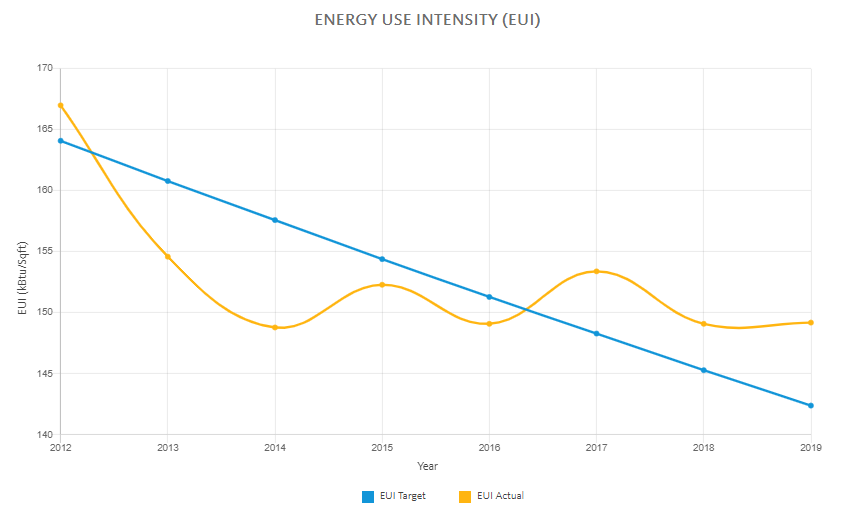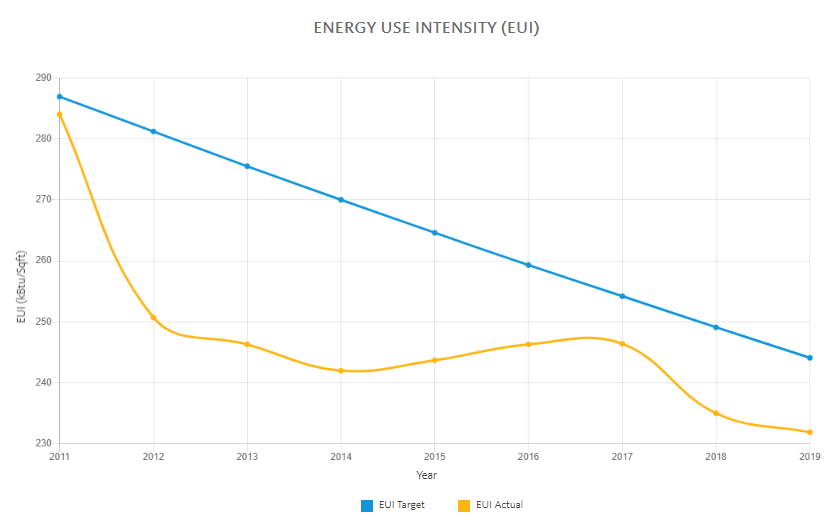We are changing the kind of energy used on campus and reducing how much we use.
Our goals date back to the first version of the UC Policy on Sustainable Practices, adopted in 2004.
Background Sustainability Goals Progress Campus Actions FAQs
Background
We are making a big shift towards energy efficiency and carbon neutrality!

What energy sources do we use?
UC Davis uses mainly electricity and natural gas, along with some gasoline, diesel, propane, and kerosene. All of these sources contribute to greenhouse gas emissions and have other environmental and health impacts, including those related to mining and fracking. Using less energy and procuring clean energy are key strategies to achieving a sustainable university.
Where do we use energy?
The largest proportion of campus electricity and natural gas consumption is in campus-owned and operated central plants:
- The Davis campus currently operates a district steam distribution system to heat nearly 70 percent of the buildings on its core campus and a separate district heating system at a research center on the west campus. , and operates a district chilled water system to provide cooling in buildings.
- The Sacramento Health campus currently operates a combined heat and power (also called co-generation) plant that serves most of its buildings. The plant generates both electrical power and steam for hot water and building heating. Sacramento’s central plant also makes chilled water for cooling most of its buildings.
We also use energy for lighting, heating, cooling, and equipment in buildings and facilities that are not connected to our central plant district systems, as well as on outdoor lighting, and for back-up generators.
Find out more about UC Davis greenhouse gas emissions and our climate action plans.
Sustainability Goals
- Energy Efficiency
- Reduce campus energy use intensity (EUI) by an average of at least 2% per year.
- Renewable Energy
- Install additional on-site renewable electricity supplies and energy storage systems at the campuses and health locations whenever cost-effective and/or supportive of the location’s Climate Action Plan or other goals.
- By 2025, each campus and health location will procure 100% clean electricity.
- By 2025, at least 40% of the natural gas combusted on-site at each campus and health location will be biogas.
Progress Toward Goals
Energy Efficiency
The Campus Energy Education Dashboard reports that the Davis campus is using less energy today than twenty years ago, despite campus growth in both building square feet and population (employees and students).
EUI Graph for UC Davis
As of July 2020

Source: UC Sustainability Annual Report 2020
EUI Graph for UC Davis Health
As of July 2020

Source: UC Sustainability Annual Report 2020
Renewable Energy
On-Site Renewable Energy
UC Davis has extensive on-site solar power generation infrastructure (values are in megawatt-direct current (MWdc) or kilowatt-direct current (KWdc) capacity).
|
Type |
System Size |
Location |
|---|---|---|
|
Ground mount solar (tracking) |
16.3 MWdc |
Davis – south campus |
|
Rooftop / Parking |
756 KWdc |
Davis – multiple locations |
|
Rooftop / Parking |
145 KWdc |
Sacramento – Medical Center campus |
|
Rooftop / Parking |
4 MWdc |
West Village |
- Learn more about our on-site renewable energy projects.
Off-site Renewable Energy
UC Davis is a major contributor to the University of California's system-wide voluntary renewable energy program with our on-campus and off-site renewable energy projects and contracts.
- Learn more about our off-site renewable energy procurement.
Campus Actions
UC Davis employs three broad strategies to reduce and clean up its energy use:
- Energy efficiency and conservation
- On-site renewable energy production, including solar and biogas
- Off-site renewable energy procurement
Implementing these strategies is a collaborative effort involving many administrative and research units at our campuses and systemwide.
Energy Efficiency and Conservation
The UC Davis Energy and Engineering team in Facilities Management runs energy efficiency programs and activities to reduce energy use on campus, including:
- Energy efficiency projects in individual energy-intensive campus buildings identified as having greater opportunity for energy savings;
- Building scheduling, so that heating, ventilation and air conditioning (HVAC) systems run when people are in the buildings, and holiday shutdown schedules to reduce energy waste when campus is quiet during holidays;
- “ECO mode” for labs to safely reduce ventilation rates in spaces designed as labs but currently used for non-hazardous activities; and
- Measurement and verification of energy savings to quantify the success of projects to save energy on campus.
Other campus-wide initiatives and programs that advance and promote energy efficiency and conservation include:
- The Big Shift will help move UC Davis toward the goal of carbon neutrality by 2025. Right now, buildings in the Davis central campus are heated by an underground steam heat distribution system. This 75-year-old system is fueled by natural gas, and accounts for about 40% of the campus's energy-related carbon footprint. In 2020, we started construction on a new, energy-efficient hot water system. Learn more and track project progress.
- The Smart Lighting Initiative to improve the quality and efficiency of indoor and outdoor lighting on the Davis campus. It is a collaboration of the UC Davis California Lighting Technology Center (CLTC) and the Davis offices of Sustainability, Facilities Management, Design and Construction Management, and Utilities. It implements lighting technologies, innovations and strategies developed at the CLTC and demonstrated through pilot projects on campus.
- Green Workplace, where you can learn how to reduce your energy consumption in your lab, office, or even home office or study space!
Renewable Energy
In order to meet our goals, UC Davis actively pursues renewable energy sourcing.
On-site Production
- UC Davis has a 16.3 MWdc ground-mounted South Campus Large Solar Power Plant, operating since summer 2015. As of spring 2021, this solar installation was still the largest on any North American university.
- The university additionally has nearly one megawatt of generating capacity installed elsewhere on parking lots/structures and rooftops on both the Davis and Sacramento campuses.
- West Village has about 4 megawatts installed, and operates its own grid with service from Pacific Gas & Electric. Most of the electricity generated from this installation is used by the private apartments in West Village; some of it is used by the UC Davis Energy and Efficiency Institute research units located in West Village.
Find more information about our on-site renewable energy projects.
Off-site Procurement
- UC Davis procures off-site renewable energy from several sources. Renewable Energy Certificates (RECs) certify the green energy production from off-site solar power plants.
Find more information about our off-site renewable energy procurement.
A Few More Energy FAQs:
- What is the difference between energy and power?
- Simplistically, energy enables an action or work to be done; and power is the rate, or how fast, energy is “used” to do that work. For planning and implementing energy efficiency, energy conservation, renewable energy procurement, and greenhouse gas emissions reduction actions, we want to know our total energy consumption over some period of time. For example, electricity consumption is measured in kilowatt-hours. So, to calculate energy savings from an energy efficiency or conservation project, we want to know how many kilowatt-hours we’d save by doing the project.
- What is energy efficiency and how does it differ from energy conservation?
- Basically, energy efficiency is getting more work done per unit of energy input, and energy conservation is reducing the amount of energy used. Energy efficiency involves technological improvements, such as a project that updates an energy-using system – like a building’s heating, ventilation and air conditioning equipment – to do the job with less energy input than the old, less efficient system. An energy conservation action is behavior-based – like turning off a light when you are not using it – which saves energy by stopping or reducing the energy use, rather than making the light more efficient. If you replace an old incandescent light bulb with an LED bulb, and then turn it off every time you aren’t using it, you’ll be undertaking both energy efficiency and energy conservation.
- What is energy use intensity, or EUI?
- Energy use intensity (EUI) is a gauge of how energy efficient a building is. EUI assesses a building's annual energy use, measured in energy – expressed in thousands of British thermal units (kBTU) – divided by building square footage (sf), and the formula is shown as kBTU/sf/year. Electricity and natural gas consumption can be converted from kilowatt-hours (kWh) and therms into British thermal units (BTU).

